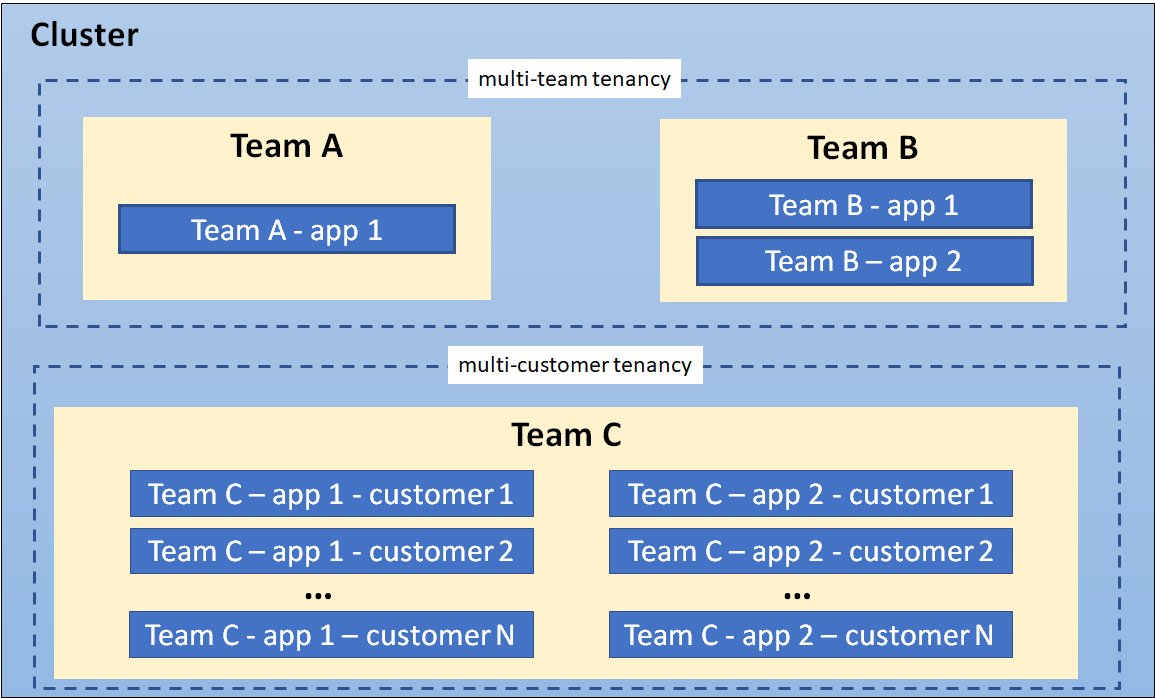Multi-tenancy in Kubernetes
 Oreoluwa Onanuga
Oreoluwa Onanuga
In today’s era of virtualization and container orchestration across a wide range of applications, the need to effectively manage Kubernetes clusters has become essential. This brings us to the concept of multi-tenancy in Kubernetes, where multiple users and/or teams can share a single Kubernetes cluster, easing administration and saving costs.
So Who Are the Tenants?
In Kubernetes multi-tenancy, the 'tenants' are typically the various teams, users, or even entire organizations sharing the same Kubernetes cluster. Depending on the required level of isolation, different techniques can be employed to securely partition resources. The degree of isolation often dictates whether a 'soft' or 'hard' multi-tenancy model is in place. For instance, consider a scenario with both Development and Production environments—each can function as separate tenants while still sharing the same Kubernetes cluster.

Picture Credit: Kubernetes Docs
In certain cases, multi-tenancy within a single cluster may not be enough, as the requirements may call for multiple, dedicated clusters instead. So, what’s the best approach? Start by carefully studying your requirements! Understanding your specific workloads, security needs, and resource constraints will help you decide whether a multi-tenant setup or multiple clusters best fits your application architecture.
Soft and Hard Multi-tenancy
Isolation techniques like namespace isolation, network policies, RBAC authorization, and GitOps controllers help define the boundaries between soft and hard multi-tenancy in Kubernetes. Consider the Development and Production environments mentioned earlier: these tenants often require stronger isolation to prevent interference, which can be achieved through methods like RBAC authorization and network policies. This stricter isolation level distinguishes hard multi-tenancy, where environments operate independently, from soft multi-tenancy, which takes a more flexible, less isolated approach.
Isolation Techniques in Kubernetes Multi-tenancy
Now that multi-tenancy could be the key to optimizing your Kubernetes cluster, the next question is: how can you achieve it? What isolation techniques are necessary to establish secure, efficient multi-tenancy? Here are some effective isolation methods. Keep in mind, there’s no specific order or set number of techniques to implement; the requirements of your multi-tenancy setup will guide which techniques are most appropriate.
Namespace Isolation: In Kubernetes, namespaces provide a way to isolate groups of API resources within a single cluster. This is one of the simplest techniques to implement, making it a popular choice for achieving basic isolation. A simple way to create a namespace is to run the command:
kubectl create namespace Cloudville-DevHere a namespace called Cloudville-Dev will be created.
Network Isolation: Network policies can provide isolation at the network level, controlling traffic flow between namespaces or even individual pods. To use network policies, your cluster must run a CNI (Container Network Interface) plugin that supports them, such as Calico or Cilium.
Click here to learn more about network policiesAuthorization: Role-Based Access Control (RBAC) can be implemented to restrict tenant access, ensuring users or teams are confined to their specific namespaces and resources, maintaining security and privacy within the cluster.
Resource Quotas: Resource quotas limit resource consumption per tenant within a namespace, ensuring fair usage across the cluster. The following manifest sets quotas for pods, secrets, replication controllers, and services in the Cloudville-Dev namespace.
apiVersion: v1 kind: ResourceQuota metadata: name: Cloudville-Dev-Quota namespace: Cloudville-Dev spec: hard: cpu: "1" memory: 1G persistentvolumeclaims: "10" pods: "2" replicationcontrollers: "2" resourcequotas: "1" secrets: "5" services: "3"
At the end of this guide, you should now have a solid understanding of how multi-tenancy works in Kubernetes and the techniques available to achieve it. I hope you feel inspired to explore multi-tenancy in your own clusters. Good luck, and happy orchestrating!
Subscribe to my newsletter
Read articles from Oreoluwa Onanuga directly inside your inbox. Subscribe to the newsletter, and don't miss out.
Written by